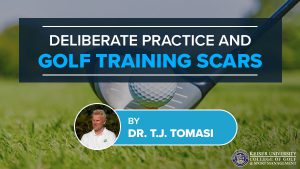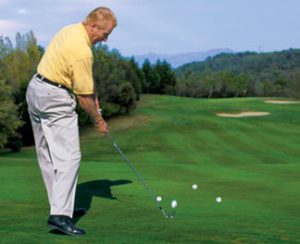Deliberate Practice and Golf Training Scars

By Dr. T. J. Tomasi, Keiser University College of Golf Senior Faculty and Director of Research
As part of his concept of original practice, originator Anders Erickson says that how players structure their practice routine is the crucial factor, and to learn best they must constantly challenge themselves, which means developing a practice protocol that always demands a bit more.
Deliberate Practice
Deliberate practice is a special kind of practice yet something almost anyone can do. The bad news is that deliberate practice is often difficult and not very much fun, i.e. it’s hard work that embraces failure as a learning tool. Almost every study on how people become experts shows that the sine qua non that separates the good from the great is the hard work done after one learns the basics — and the centerpiece of this process is deliberate practice.
Erickson doesn’t deal with golf specifically, but his research begs the question “what goes into making up a complete training protocol for a sport like golf? The first thing is to create an accurate strength and weakness profile because it is this profile that a golfer will fit into the defenses set up by the golf course architect given the circumstances and the conditions of play.
Your goal when you play golf is to choose the correct solution for each Point A to Point B problem that you face on the course and the key to the correct solution is to always present one of your strengths against the defenses arrayed against you. For example, while the shot to the pin requires a high drawing 3-iron, if this shot pattern is not a strength then you must choose another club which is a strength such as a choke-down five-metal. If you have no shot strength for this particular Point A to Point B, then it’s off to the practice tee to acquire a new strength. It’s simply axiomatic that you cannot effectively solve Point A to Point B problems if you don’t know what your strengths and weaknesses are.
Golf Training Scars
The next step in the development of your training protocol is to avoid training scars [TS] — mistakes that are unintentionally learned by using flawed practice procedures. Unfortunately, TS are difficult to identify and eradicate because, like termites in the foundation, they hide in the very fabric of the protocol itself so when the protocol runs, so do the training scars. So, it is that TS degrade the value of the information passing through the protocol.
The 50 Hour Fork in the Road
The French philosopher Voltaire warned that ‘perfect is the enemy of the good’ but this is not always true in golf. Erickson’s research shows that after about 50 hours of successful deliberate practice a crucial juncture is reached where the non-expert falls behind in development while the expert continues his/her march to the PERFECT. Researchers believe that it is at this 50-hour point that the developing player abandons self–challenge because the swing is “good enough.” Unfortunately, unbeknownst to the learner, it is too early in the learning process to jettison the feedback loop that provides constant, perfect refinement. This abandonment results in the installing of a swing action that is [1] “merely” adequate and [2] lodged in the long-term memory storage bin making it very hard to overwrite. Basically, you have immortalized mediocrity — instead of Alexander the Great, you are Alexander or Alexandra the Mediocre.
The expert, on the other hand, doubles down on using continuous feedback and correction thus preventing ensnarement in the trap of introducing flawed technique into permanent memory storage. For example, Olympic skaters fall more in practice then do less accomplished skaters because they are constantly pushing the envelope trying to improve. As the Navy SEALs say: “You’ve trained enough to do it perfectly – now do it again”.
Storing Imperfect Information
Presenting your motor memory with inaccurate information is serious TS since the brain learns the bad just as ‘perfectly’ as it learns the good. With the arrival on the modern scene of sensitive radar tracking technology, teaching principles of golf have undergone a radical change. Over the past several years I’ve outlined these changes in my nationally syndicated column and in articles in national magazines. Slowly this new information is making its way into the teaching protocols of golf instructors all over the world ensuring that correct swing information is up to date.
Prior to this, almost all teaching protocols contained the TS based on bad information regarding what causes ball flight. This benefitted the great players such as Jack Nicklaus, Lee Trevino, Byron Nelson, Sam Snead, and Ben Hogan etc. i.e. the few who figured out on their own the secrets revealed by TrackMan before TM ever was – as Hogan said, “I dug it out of the dirt with 10-years of experimentation.”
Side Note: Since this information is now readily available to all golfers and teachers, the days of domination by a few great players may well be over. Of course there will always be a few great players in each era but I will bet that if you match the three greatest players of each time frame [e.g. Sarazen, Hagen and Jones vs Hogan, Snead, Nelson vs Palmer, Nicklaus, Trevino vs Watson, Norman, Ballesteros vs Woods, Woods and Woods] it would be very competitive – but match the top 100 golfers in each era and the modern team wins because it is so much deeper due to TM info.
If you’re a one trick pony with only one ball flight, here’s a drill to expand your shot repertoire. Here’s how to reduce your TS in this regard:
To improve your ball striking use the diamond drill.

- Tee up your ball and arrange three others in a triangle two feet or so in front of your ball. The top ball of the triangle should be on the target line with the other two on either side.
- Your task is to hit three balls per series: one that starts over the right ball and curves back to the target; the second goes directly to the target over the front ball; and the third starts over the left side of the diamond and fades back to the target.
- When you can do three series in a row [9] without mistakes, you’ll be accurate to any target.
Note: For a right-handed golfer a fade is a curve on the ball from left to right and it’s the opposite for a draw. A fade for a pro is a straight ball that gets to the top of its flight pattern, then falls to the right about three or four yards. When you see a good player fade the ball it looks like a straight shot to the untrained eye; but no matter who’s looking at it, the slice is noticeable. Most golfers slice the ball creating a shot that starts curving soon after it begins its flight and by the time it’s on the ground it may have curved 20 or more yards. The fade is easy to control, the slice is not. And it’s the same for the hook. So, here’s the rule of thumb – if you can see the curve immediately it’s a slice or a hook; if you have to wait to tell, it’s a fade or a draw.
If you’d like to study with Dr. Tomasi and other PGA Master Professionals, contact The College of Golf today.














